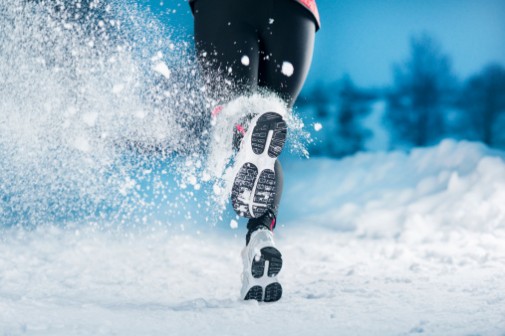Running in winter; Yes you can!

When temperatures drop and snowflakes fall, many runners leave behind the roads, trails and tracks for the treadmill, elliptical and other indoor workout activities. However, for those who do not want to give up running outdoors, being properly prepared can make a cold weather run both safe and enjoyable.
Runners need to make sure they have appropriate clothing to avoid frostbite or hypothermia. Frostbite can occur when the body is exposed to cold temperatures, usually affecting appendages like fingers, ears and toes first. Hypothermia often is caused by overdressing, which makes athletes sweat more so they become wet and cold.
“Water transfers heat more effectively than air, so hypothermia begins to set in when the body’s core temperature falls to 95 degrees,” explains Dr. Steven Chudik, a sports medicine physician and orthopedic surgeon at Advocate Good Samaritan Hospital in Downers Grove, Ill. “The trick to avoiding hypothermia is to keep moving and wear appropriate layers of clothing so you do not sweat profusely.”
To stay warm and dry, Chudik recommends that runners follow the layering rule of three:
• Layer 1: A wicking layer to absorb sweat off the skin and keep the body dry
• Layer 2: An insulating layer to provide warmth
• Layer 3: A protective layer to resist the wind
It is also important to keep the face, ears, fingers and toes properly covered. Wear gloves and a hat or ski mask. To keep feet warm and dry, do not wear cotton socks since they will absorb sweat. Instead wear socks made of neoprene or wool, which wick away sweat.
Many runners make the mistake of not drinking enough water before and during their run, which can lead to dehydration.
“Cold temperature diminishes thirst so athletes do not feel an urge to drink while running,” Dr. Chudik says. “We actually need more fluid for the process of respiration when it is cold so athletes need to plan ahead so they have accessible locations with water along their run.”
After a long run outdoors, runners who are dressed appropriately should not feel cold. For those who are feeling extremely cold, Chudik recommends these steps:
1) Get out of the cold, remove wet clothes and redress.
2) Cover with warm blankets, hot water bottle or heating pad to raise body temperature.
3) Take a pain reliever because warming can cause pain.
4) Refuel with food containing carbohydrates, proteins and fats, and make sure to drink. Food and nutrients are required to make heat and will provide the body with short- and long-term energy.
5) If a runner may have experienced frostbite, take a warm shower with water at 100 degrees but do not rub the affected area.
6) Seek medical attention as soon as possible for frostbite or hypothermia.
While running in the cold may not be the most popular exercise this winter, for those running in a holiday 5K or who don’t want to interrupt their outdoor routine, a little preparation can keep you running safely year-round.
Related Posts
Comments
One Comment
About the Author
health enews staff is a group of experienced writers from our Advocate Health Care and Aurora Health Care sites, which also includes freelance or intern writers.


















Nice tips- unfortunately, I don’t think there is any tip that will get me out and running in the cold winter months!